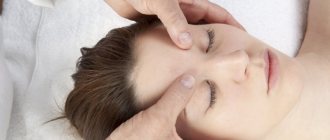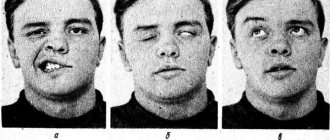Most often, signs of stuttering manifest themselves in the inability to stream coherent speech, expressed in involuntary duplication of individual syllables and sounds, unnecessary pauses and prolongation of pronunciation of both individual words and verbal structures (phrases and sentences).
Such disorders are most often associated with periodic spasms of the facial muscles. Such failures can occur for psychological reasons (stress), neurological reasons (general immaturity or active growth of the nervous system that outstrips the body’s capabilities), or physical reasons (organic brain damage due to congenital pathologies or injuries, blows to the skull).
Organic (physical) lesions include: birth or acquired traumatic brain injuries in childhood, various neuroinfections, pathologies (usually perinatal. For example, hypoxia, asphyxia, etc.).
Psychological circumstances include deep nervous disorder due to prolonged stress, growth of fears (phobias) and complexes of the child due to the high conflict environment. In particular, the level of conflict is influenced by:
Excessively strict parental education (physical punishment and moral pressure, humiliation); Frequent family quarrels and scandals; Unfavorable social environment (at school, in the yard, when communicating via the Internet through games, social networks, etc.)
In this case, logoneuroses occur against a background of high anxiety and sleep disorders (insomnia, increased sensitivity, shortened phases of deep sleep, causing depression and “constant fatigue” syndrome, etc.)
Also, stuttering is often complexly associated with concomitant disturbances in the reproduction of sound flow:
- Alalia - a late date for the start of independent coherent speech broadcasting;
- Dyslalia - the inability to articulate individual sounds caused by neurological reasons;
- Dysarthria - impaired pronunciation of words and sounds due to limited mobility of the speech apparatus;
- Rhinolalia - distortions in the speech apparatus due to deformations caused by velopharyngeal non-closure (colloquially: “cleft lip”, “cleft palate”, etc.).
Causes of stuttering in teenagers
Mostly, the pathology appears in childhood: at 3–4 years. If stuttering is diagnosed in adolescents or an adult, this means that correction was not carried out at the right time or it was inadequate. But there are also cases when pathology appears for the first time in adolescence, and before that speech is normal.
In cases where pathology first appears in adolescents, this happens for several reasons:
- genetic predisposition, when there are disturbances in the functioning of the nervous system, when exposed to provoking factors they lead to stuttering or other speech disorders;
- neurological pathology;
- the presence of other speech defects, while the violation may be minor and not interfere with the teenager, but causes fear and spasms;
- difficult relationships in family, school, company;
- conflicts, stress;
- excessive stress on a teenager - both physical and psychological: a complex curriculum, tests, tests, exams;
- unfavorable environment - dysfunctional family, lack of attention on the part of parents, their indifference to the child;
- the opposite situation is too high demands made by parents, pressure and expectation from him of excellent studies, good results in all areas. At the same time, parents do not take into account the developmental characteristics of their child, his character and abilities;
- injuries of the central nervous system - at birth or after;
- infectious diseases, intoxications, endocrine disorders that affect the brain, especially if they are severe;
- convulsive reactions.
Whatever the cause, stuttering is not just a speech impediment. In most cases, this is a dysfunction of the nervous system with many consequences. Therefore, eliminating stuttering in adolescents is a complex task, in the solution of which several specialists take part: speech therapist-defectologist, neurologist, psychologist or psychiatrist.
2. Reasons
The role of socio-psychological factors in the development of stuttering is well known and obvious. Such factors include situations of acute and chronic distress, psychotrauma, experienced states of shock (after which speech may be completely lost for some time, recovering with stuttering), socio-pedagogical neglect, unhealthy microclimate in the family, inflated levels of expectations and requirements for child, lack of attention and communication, unconscious and unreacted internal conflict, etc. Actually, this is why stuttering is classified as a neurotic disorder, because it is almost always based on one or another psychogenia.
However, the pathogenesis of the development of logoneurosis at the level of CNS functioning remains essentially unclear. Over the last century, a number of serious hypotheses and theories have been put forward, from psychoanalytic and behavioral to psycholinguistic and neurophysiological, but all of them, at best, are only more or less successful models that can answer some questions and do not solve the problem as a whole. Thus, until recently, the role of genetic factors was apparently underestimated (hereditary predisposition could explain, among other things, the predominance of males among those who stutter) and/or the significance of hormonal imbalance (in particular, abnormal concentrations of the neurotransmitter dopamine). To this day, it is unknown why logoneurosis occurs in such different variants and what exactly determines the clinical specificity under seemingly identical initial conditions.
It is not always possible to find a reason in the anamnesis (including in the sphere of the unconscious and repressed) that could be considered quite serious: many children and adults who have experienced more than severe psychological trauma do not show any signs of stuttering.
Electrophysiological, tomographic and other instrumental diagnostic methods also do not yet provide comprehensive information about the connections between stuttering and organic changes in the structures of the brain, in particular, Broca’s area, the functioning of which is directly associated with speech.
The situation is further complicated by the fact that stuttering often develops like a vicious vicious circle: a child with a speech disorder experiences enormous discomfort about his “inferiority” (especially if he is subjected to ridicule or other pressure), may withdraw, fall into a severe depressive state, begin to be afraid and avoid verbal communication in general, abandon all attempts and faith in the possibility of a cure; the growing intrapsychic tension, thus, according to the feedback principle, progressively aggravates logoneurosis.
Research in this area is being carried out in leading psychoneurological centers around the world, but today correction techniques (developed, for the most part, empirically) are more successful than attempts to create a consistent and fairly complete theoretical basis, which in turn would open the way to development of truly etiopathogenetic therapy.
Visit our Neurology page
General recommendations for the treatment of stuttering in adolescents
Parents' actions should begin with consultation with a specialist. The speech therapist will examine the medical history, speech characteristics, and ask about past illnesses, injuries, and possible causes that led to the disorder.
Self-medication on the advice of friends, without an in-person examination by a specialist, is unacceptable. This can make the situation even worse.
After the examination, the speech therapist refers the patient for consultation with specialists:
- a neurologist conducts a study to identify abnormalities in the nervous system. For this, skull radiography, electroencephalography, rheoencephalography, MRI, CT are used;
- the otorhinolaryngologist excludes diseases of the ENT organs that may affect speech;
- psychologist works with personality disorders.
If necessary, other doctors also work with the teenager: an endocrinologist, a psychiatrist.
After a complete diagnosis, the speech therapist selects treatment tactics for stuttering in adolescents. In mild cases, when stuttering occurs sporadically, in moments of emotional stress, it is enough to do the exercises yourself. Difficult situations when the defect is constantly present and interferes with normal life, medicinal treatment methods, massage, physiotherapeutic methods, and even hypnosis are used.
Typically, therapy is long-term: it may take more than one year to cope with the problem. An important condition is continuity of treatment: complete one course, rest a little, and start the next course. Follow all recommendations of the speech therapist. If you don't care about a teenager's speech impediment, he will follow your example and won't try.
Remember: only the joint efforts of the speech therapist, parents and the child himself will help achieve results.
Even after recovery, you should be on your guard: under unfavorable conditions, stuttering in adolescents can recur. Therefore, it is very important to eliminate all risk factors: avoid stress, reduce stress at school, create a favorable atmosphere at home.
Stuttering in childhood
With logoneurosis, mandatory treatment is necessary. It is preferable to carry out a treatment course at as early an age as possible. Under no circumstances should you wait until it “goes away on its own” or the child “outgrows it.” Problems with stuttering almost never go away on their own.
The importance of curing stuttering in early childhood is due to the actively developing socialization skills during growing up. It is very important for a child to learn to fully communicate with others.
A neglected neurotic withdrawal is guaranteed to damage the child’s social adaptability: it will cause low self-esteem, the development of psychological complexes (for example, to public speaking or logophobia in general - the fear of speaking to anyone), will lead to low school performance and learning ability, to severe nervous breakdowns, aggravated by the hormonal activity of adolescence.
Breathing exercises
When a teenager stutters, a spasm occurs in the muscles involved in articulation. The type of breathing is thoracic, which means superficial. Therefore, eliminating stuttering in adolescents begins with developing deep diaphragmatic breathing.
After classes, the diaphragm develops and the ligaments become more mobile so that the child begins to use breathing correctly in the process of speech formation, and maintain the pace of inhalation and exhalation. Hesitations associated with lack of air disappear, which means that fear goes away and the teenager becomes more relaxed.
There are many breathing exercises techniques, the most effective and popular is the method of A. N. Strelnikova. The technique is based on rhythmic breathing movements overcoming the resistance of the diaphragm.
The technique is as follows: the child takes a sharp breath, while making some movement, using the diaphragm muscles. After a series of breaths, he exhales calmly, then a new series of breaths. And so several repetitions.
As an example, here are a few exercises:
- “Palms” - the teenager stands or sits, arms along the body. During several successive sharp breaths, he should clench his fists rhythmically: and so on 8 times. Then exhale and a new series of breaths;
- “Pump” - legs apart, arms along the body. During inhalation, the child should bend forward, arms hanging down, back rounded. Exit - returns to the starting position;
- “Hug your shoulders” - arms in front of you and bent at the elbows, palms facing down, forearms on top of each other. When inhaling, you need to hug yourself by the shoulders, while your arms form a triangle.
The mechanism of occurrence of logoneurosis, stuttering
The mechanism of logoneurosis (stuttering) is quite complex. It is necessary to take into account the role of predisposing and permissive factors. Predisposing factors include unfavorable conditions of premorbid development, which can slow down, or less often accelerate, pause or distort the development of speech. If this predisposition is expressed to a strong degree, then logoneurosis can occur under the influence of even minor or unclear resolving influences. Stuttering is associated with interhemispheric asymmetry and dominance of the cerebral hemispheres. Sometimes children who stutter are left-handed. In these cases, stuttering is facilitated by an inept attempt to re-educate left-handedness, which disrupts the relationship between the dominant and non-dominant hemispheres.
Folk remedies
Folk remedies can be effective in eliminating stuttering in adolescents. But they cannot replace other correction methods: drug therapy, physiotherapy, massage, classes with a speech therapist and psychologist. Therefore, be sure to consult with your doctor before starting treatment. Moreover, some products have contraindications - only a specialist will tell you all the nuances.
The most commonly used means are:
- inside - oregano, lavender flowers, drupes, linden blossom;
- externally (baths) - with rosemary, peony.
Correction of logoneurosis at MC “VERAMED”
In the network’s clinics, you can visit a psychologist and neurologist, get advice from a speech therapist and reflexologist who know what new treatment or the latest achievements, correctional techniques are used in the world to correct speech problems. VERAMED specialists are ready to offer comprehensive treatment for stuttering, as well as individual procedures, speech therapy sessions, massage, acupuncture - what your doctor prescribed. The price of services is competitive and affordable, and the experience and qualifications of our specialists allow you to be confident in a professional approach to a delicate problem. They have extensive knowledge, the most modern therapeutic techniques and new equipment in their hands. Make an appointment in Odintsovo or Zvenigorod by calling a single call center.
Logorhythmics
Treatment of stuttering in adolescents using logorhythmics is aimed at improving speech rhythms and creating smooth, expressive speech. Exercises affect breathing, movement, sensory and speech motor areas. Also, such activities have a positive effect on the emotional and volitional qualities of the patient, making him more active.
During classes, the child makes movements, while rhythmically pronouncing some sounds.
For classes you need music - at different tempos (fast, moderate, accelerated, slow, rapid), which helps the child quickly switch from one type of movement to another. You also need speech material - tongue twisters, rhythmic sentences.
An example program could be like this:
- introductory exercises - walking for the ability to control movements, the ability to walk at different paces;
- chanting to develop speech breathing, coordinating singing with hand movements;
- singing and its coordination with walking - aimed at developing rhythmic hearing, attention, understanding of the character and tempo of music;
- exercises for coordinating melodic speech with movements - the child learns to control his muscles;
- listening to music, exercises to stimulate musical memory;
- game exercises to develop emotionality and stimulate imaginative thinking;
- final exercise of a calm nature.
Or you can pronounce tongue twisters: first short ones (within 2 weeks), gradually choosing more complex and longer ones, with sounds and words that are difficult to pronounce.
Forms of logoneurosis, stuttering
Logoneurosis (stuttering) is a complex speech disorder when its smooth flow is interrupted by convulsive spasms of the speech muscles, manifested by a disorder of its normal rhythm, distortion, involuntary delays, as well as forced repetitions of individual sounds and words due to a functional disease of the nervous system.
Logoneurosis (stuttering) manifests itself in three forms: clonic - repeating a word several times; tonic - convulsive pronunciation of the first letter; Secondary stuttering occurs in speech pathology, epilepsy, and neurotic disorders. Anxiety worsens stuttering. What is the clinical picture of logoneurosis, what are the symptoms of logoneurosis? With logoneurosis, a person stutters at the beginning of a word, or in the middle of a word, or at the beginning and in the middle of words.
Massage
Massage eliminates the excitability of speech centers and restores speech regulation. To eliminate stuttering in adolescents, acupressure, probe or segmental massage is used. The specialist influences:
- neck area;
- upper shoulder girdle area;
- facial muscles;
- muscles of the lips, tongue;
- larynx area.
The massage therapist massages the listed areas one by one. First it smoothes them, then taps them (vibration), stretches the skin and muscles. Each area has its own set of movements. Massage of the tongue and lips can be carried out using special probes. They act precisely, stimulating certain points.
The effect can be noticeable after the first procedure: muscles relax, spasm is eliminated, speech becomes smooth, without hesitation or pauses. To consolidate the result, a full course of 10–12 sessions is required. After a short rest, the duration of which is determined individually, a repeat course begins.
Ask a speech therapist to teach you self-massage techniques. By performing massage yourself as an addition to the main course of treatment, you can achieve greater results.
Treatment
There are several methods for treating stuttering. One of the main ones is breathing exercises. The set of exercises is aimed at relaxing the neck muscles, training deep breathing and the diaphragm, which is involved in the formation of the voice.
Speech therapy classes are conducted individually or in a group; their task is to develop the child’s independent speech skills, sense of rhythm, relax muscles and relieve emotional stress. The duration of the course may vary, from several months to a year, depending on the chosen technique. Patient reviews justify their effectiveness in stuttering treatment methods such as segmental and acupressure massage, psychotherapy, autotraining, and reflexotherapy. With complex therapy, it is possible to treat logoneurosis with medications.
Other therapies
As we have already said, the greatest result will be when using several correction methods. In addition to the above, the treatment package for stuttering in adolescents includes:
- Drug therapy - the doctor selects the drug individually. These can be nootropics, sedatives, vitamin complexes, immunostimulants. It is advisable to use them simultaneously with other treatment methods;
- Classes with a speech therapist help to form correct articulation and breathing;
- Classes with a psychologist (group, individual) instill self-control skills, help get rid of psychological problems, overcome complexes, and adequately treat your problem: do not focus on it, but also do not pretend that everything is normal. This will help a teenager with a stutter feel more confident and equal to his peers. He acquires psychological stability, which of course will help him in later life;
- Physiotherapeutic procedures help relieve muscle spasms and increase blood circulation;
- Acupuncture involves influencing reflexogenic points. The specialist installs special needles on points that are associated with speech function;
Treatment is usually outpatient. In complex cases, for example, neurological pathology, treatment of stuttering in adolescents is carried out in an inpatient setting. When parents have the opportunity, sanatorium treatment is recommended.
Many parents wonder how to quickly get rid of stuttering for a teenager? Experts recommend various relaxation methods: it is different for each person. Meditation, hippotherapy (treatment with horses), art therapy (treatment with drawing) - offer these methods to your child. Perhaps he will like something and develop into his hobby.
Either way, be there for your child. Adolescence is a difficult period for him. With your support it will be easier for him to cope with his problems.
Treatment methods
Treatment of logoneurosis must be carried out comprehensively with the development of an individual treatment strategy for each individual case. At the first stage, it is necessary to conduct an examination by a neurologist. He will diagnose the causes of stuttering and draw up a treatment plan.
There are several medical centers in Russia that successfully use the silent technique to cure logoneurosis.
However, often clients of such centers, even if they want to, are not able to comply with the conditions of complete isolation from family and social life, both due to personal - psychological, and various socio-economic circumstances (loss of work, usual social circle, etc.).
Our extensive practical experience proves that there are less radical means to successfully change the habitual pattern not only in a child with various speech dysfunctions, but also in an adult who stutters. We adhere to European medical techniques, in particular: TMS - transcranial magnetic stimulation.
Today, our medical center is the only specialized institution in Russia that has an original protocol for the treatment of logoneurosis using TMS techniques. The medical staff of the center has the appropriate confirming certificates for admission to the use of transcranial magnetic stimulation.











